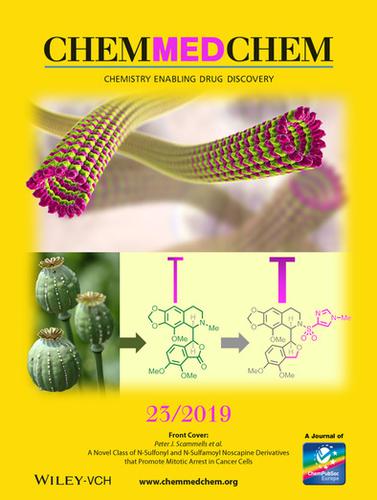当前位置:
X-MOL 学术
›
ChemMedChem
›
论文详情
Our official English website, www.x-mol.net, welcomes your
feedback! (Note: you will need to create a separate account there.)
A Novel Class of N‐Sulfonyl and N‐Sulfamoyl Noscapine Derivatives that Promote Mitotic Arrest in Cancer Cells
ChemMedChem ( IF 3.6 ) Pub Date : 2019-11-22 , DOI: 10.1002/cmdc.201900651 Cassandra Yong 1 , Shane M. Devine 1 , Xuexin Gao 2 , Angelina Yan 2 , Richard Callaghan 2 , Ben Capuano 1 , Peter J. Scammells 1
ChemMedChem ( IF 3.6 ) Pub Date : 2019-11-22 , DOI: 10.1002/cmdc.201900651 Cassandra Yong 1 , Shane M. Devine 1 , Xuexin Gao 2 , Angelina Yan 2 , Richard Callaghan 2 , Ben Capuano 1 , Peter J. Scammells 1
Affiliation

|
The Front Cover shows the natural product noscapine, which is produced by the opium poppy, Papaver somniferum. Noscapine has been used as an antitussive agent since the 1950s, but its anticancer properties and ability to inhibit tubulin polymerisation were not appreciated until the late 1990s. A number of N‐sulfonyl and N‐sulfamoyl noscapine derivatives have been identified with improved antiproliferative potency against various cancer cell lines (MCF‐7, PANC‐1, MDA‐MB‐435, and SK‐MEL‐5 cells). These antiproliferative effects were also maintained against drug‐resistant NCI/AdrRES cells despite their high expression of the multidrug efflux pump, P‐glycoprotein. More information can be found in the Full Paper by Peter J. Scammells et al.. (Photos from iStock/Getty Images by Dr Microbe & mafoto.)

中文翻译:

一类新型的N-磺酰基和N-氨磺酰基Noscapine衍生物,可促进癌细胞中的有丝分裂。
封面显示了由鸦片罂粟Papaver somniferum生产的天然产品Noscapine 。自从1950年代以来,Noscapine一直用作镇咳药,但是直到1990年代后期才意识到Noscapine的抗癌特性和抑制微管蛋白聚合的能力。现已鉴定出许多N-磺酰基和N-氨磺酰基Noscapine衍生物具有对多种癌细胞系(MCF-7,PANC-1,MDA-MB-435和SK-MEL-5细胞)的抗增殖能力。这些抗增殖作用还针对抗药性NCI / Adr RES得以维持尽管它们在多药外排泵P-糖蛋白中的表达很高。可以在Peter J. Scammells等人的《全文》中找到更多信息。(iStock / Getty Images的照片由Microbe博士和mafoto摄)。

更新日期:2019-11-22

中文翻译:

一类新型的N-磺酰基和N-氨磺酰基Noscapine衍生物,可促进癌细胞中的有丝分裂。
封面显示了由鸦片罂粟Papaver somniferum生产的天然产品Noscapine 。自从1950年代以来,Noscapine一直用作镇咳药,但是直到1990年代后期才意识到Noscapine的抗癌特性和抑制微管蛋白聚合的能力。现已鉴定出许多N-磺酰基和N-氨磺酰基Noscapine衍生物具有对多种癌细胞系(MCF-7,PANC-1,MDA-MB-435和SK-MEL-5细胞)的抗增殖能力。这些抗增殖作用还针对抗药性NCI / Adr RES得以维持尽管它们在多药外排泵P-糖蛋白中的表达很高。可以在Peter J. Scammells等人的《全文》中找到更多信息。(iStock / Getty Images的照片由Microbe博士和mafoto摄)。










































 京公网安备 11010802027423号
京公网安备 11010802027423号